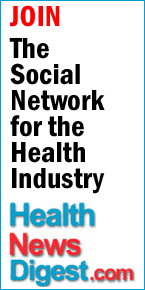(HealthNewsDigest.com) - One of the greatest challenges facing the United States today is the growing health divide in underserved communities. According to the Centers for Disease Control (CDC), an individual’s zip code is more indicative of life expectancy and health than genetics. Concurrent with the health divide is the digital divide. Despite the lowering cost of smart phones and increasingly ubiquitous internet access the divide between low-and high-income households persists. Smartphone technologies such as text messaging, health apps, and wireless monitoring sensors represent innovations that can help bridge these divides and improve health outcomes across communities. 
The first step in creating technology that can be utilized by all communities is to ensure it can incorporate the context of users. A 2015 report from the Public Health Institute (PHI) reveals that one in every four persons in the U.S. (25.7 percent) lives in a high poverty neighborhood and has limited access to basic health and economic resources. Risks and complications associated with chronic diseases have shown improvement with the utilization of evidence-based interventions such as medication management, lifestyle coaching, improved diet, and exercise, self-monitoring, and the appropriate use of healthcare services. Before implementation, there are several obstacles that these interventions face in socially disadvantaged populations: financial difficulties, poor health literacy, language and cultural barriers, lack of transportation, and provider mistrust. Technology can be used to provide support to these communities, enhance health care delivery, and provide both patients and clinicians with timely, useful data about their health status. Patient-centric technologies can enable a partnership between patients, patients’ families and practitioners, which allows for comprehensive treatment plans that considers individual needs and preferences—fully incorporating the end-user’s entire social and medical context.
The Digital Divide
Assuming the digital divide is a constituency of physical access is only partially correct. Nearly 85 percent of low-income residents of New York City own a smartphone and 62 percent of those households use the internet on a regular basis. This internet access is commonly built into their smartphones. The remaining factor for this divide then, is digital literacy. It could be the digital literacy of the individual, or it could be the social literacy of the technologies being developed. Existing technologies simply do not serve medically and socially complex households because they are not designed with low-income individuals as target users. To truly leverage technology for socially disadvantaged individuals and their communities, three things need to happen first:
1. The cost of the technology must decrease enough for it to be affordable for the individual, as the cost of smartphones has done.
2. The cost of the technology should incentivize hospitals and care facilities to adopt it for use as a preventative measure—to keep patients out of beds.
3. Finally, and most importantly, the technology must be clinically relevant and interoperable with a care facility’s current workflow, or it will not be implemented.
The onslaught of mobile health apps and the widespread misuse of fitness wearables for medical purposes cannot be relied upon to improve the health outcomes for communities that need it the most. Technologies must incorporate a meaningful feedback loop that provides accurate data to both patient and practitioner. It must be easily assimilated into the high-functioning care delivery infrastructure so that monitoring can be remote, saving both patient and doctor time and money. Most importantly, it must be designed with the users in mind.
Smartphones have helped bridge part of the divide and are an excellent precedent for the potential that technology has in permeating socially complex communities. The next step is socially responsible implementation.
Case in Point: Global to Local (G2L)
People who are diagnosed with a chronic physical health problem such as diabetes are three times more likely to be diagnosed with depression than people without it and for those who are socially disadvantaged the problems are compounded. Depression can have a serious impact on a person's ability to self-manage their condition. Poor self-management and adherence leads to poorer glycemic control and higher morbidity, which in turn leads to further depression. This vicious cycle is what technology can aim to both prevent and disrupt.
Empowering individuals to better manage their health and wellness in an accessible way is the vision of non-profit Global to Local (G2L). G2L is a Washington State-based organization committed to providing programs that improve individual and community health outcomes in two of the most diverse and underserved communities in King County, Washington: SeaTac and Tukwila. Their approach recognizes that access to good health is dependent on factors such as economic opportunity, education, language, and job skills.
Striving to bring global health to local communities, G2L is piloting approaches to improve community health outcomes for prediabetes, diabetes, and obesity with a focus on cultivating access through low-cost solutions. In 2013, G2L equipped 49 participants with smartphones, which were pre-loaded with a glucose monitoring app. Each week the participants would follow up on their progress with a case worker fluent in their native language. The intervention was successful and saw an average decrease of 1.26 in the participants’ hemoglobin A1C value, which is significant because it translates into a reduction of diabetes-related death by 21 percent as well as a 40 percent reduction in eye, kidney, and nerve disease.
Community Context
Despite success, technology alone was not responsible for the improved health outcomes of the 49 participants. Feedback from G2L suggests that the collaboration between facilitator, technology, and participant was one of the most important elements. The participants found it empowering to monitor and track their own health data with the use of the app, but they also relied on the weekly consultations with their case worker.
Gracious Gamiao, the project lead of G2L’s Mobile Health Project, explains: “The iPhone app and weekly text messages were very important tools for enabling effective and efficient communication between case worker and patient. Once the patients were comfortable and literate with the devices we really saw the motivation and learning that technology can offer; patients began to involve themselves, daily, in monitoring their health with the app and then sending reports to their case worker.”
Before any tools or devices can be applied to communities like SeaTac and Tukwila, there needs to be a realistic assessment of a patient’s knowledge and understanding of both the technology and their own health. Gamiao also cites the need for clear and effective communication between health professionals and their patients which was facilitated by the technology. The trust built between the health professional, the technology, and the patient attributed a large part to the project’s success.
Leveraging technology to improve patient health outcomes depends on whether technology can build a bridge for communications between patient, doctor, and community. Building social incentives and accountability into the technology, and understanding the context into which the technology is being deployed, are two key lessons learned from the G2L community Mobile Health Project.
Technology Can Disrupt the Health Divide
Technology presents one of the best tools for improving health outcomes on a global scale. In the United States, 76 percent of the population, across all social statuses, attested to wanting to use wearable technology for disease management if it were easy to use and the data was clinically-accurate and available for their physician. In fact, technology is already revolutionizing the understanding and treatment of disease. New devices such as medical-grade wearables are poised to further transform medicine. The lesson here is that these technologies must understand the social context of all those afflicted in order to build the most accessible solutions. By facilitating improved delivery of health services through increased access to healthcare practitioners and practical feedback, technology can offer tangible hope for the most disadvantaged communities and in turn for everyone.
About the Author:
Waqaas Al-Siddiq is Founder and CEO of Biotricity, a biometric remote monitoring solutions company. He is a serial entrepreneur, a former investment advisor and expert in wireless communication technology. He has vast experience through executive roles within start-ups, mid-sized companies, and non-profits. For more information visit https://www.biotricity.com
###









